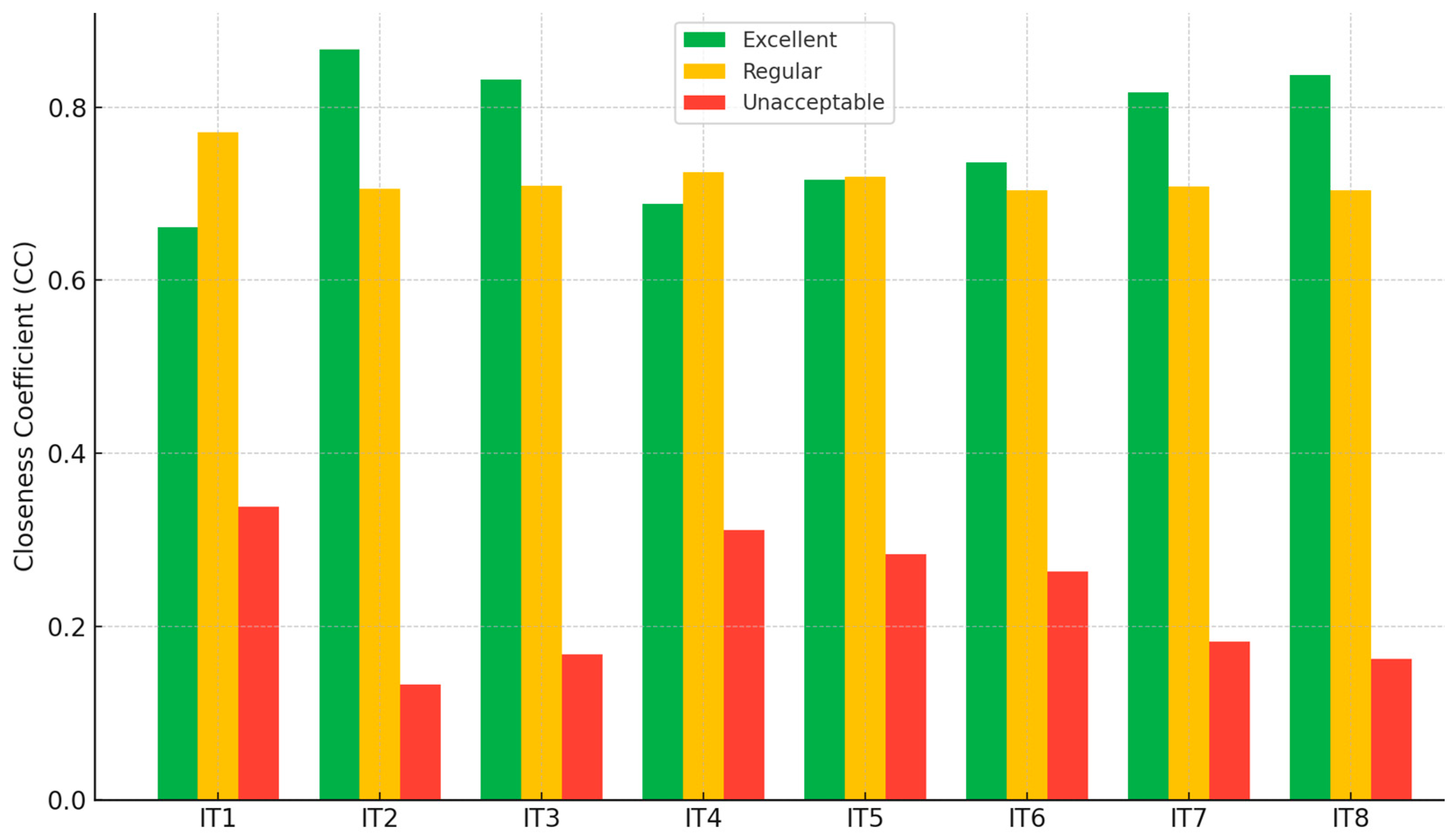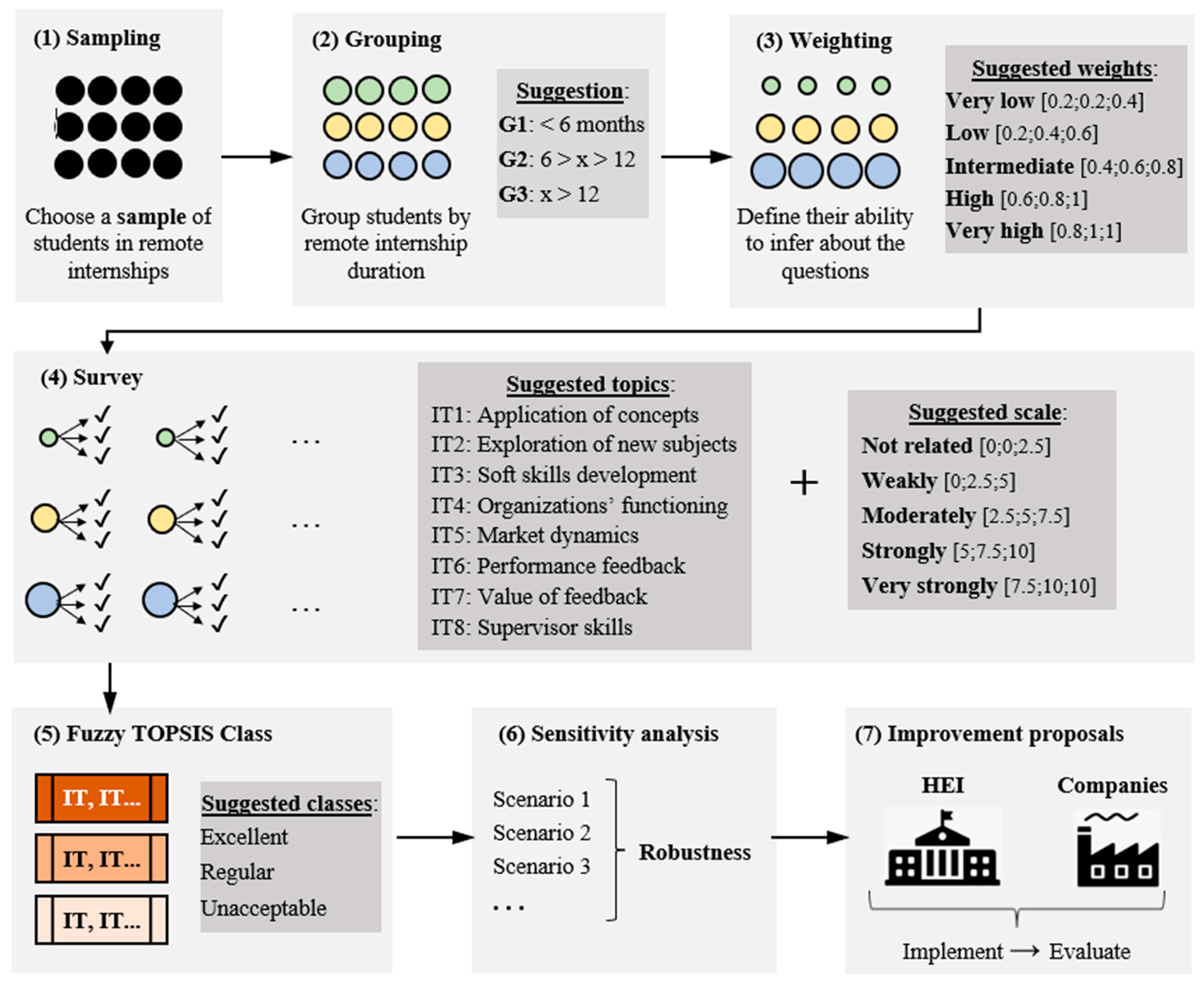4.1. Assessing the Quality of Virtual Internships in Brazilian Organizations
Given that the research involved 78 participants, and a triangular fuzzy number ( , ) was assigned to each of them, the matrices generated for the calculations of Fuzzy TOPSIS Class in MS Excel were of significant dimensions. Thus, simplified versions of these matrices are used to present the results.
Table 5 highlights the collected data, characterizing the decision matrix
with each respondent (R) assuming the role of a criterion.
Table 6 displays the weight vector
, which was constructed based on the respondents’ ability to infer about the quality of virtual internships.
The data from
Table 5 were normalized considering the benefit criteria [
23] and weighted by the weight vector presented in
Table 6, obtaining the matrix
shown in
Table 7.
The highest level of the scale (i.e., “the proposition is very strongly related to the virtual internship I undertook”) was considered as class “excellent”, the intermediate level of the scale (i.e., “the proposition is moderately related to the virtual internship I undertook”) was classified as class “regular”, and the lowest level of the scale (i.e., “the proposition is not related to the virtual internship I undertook”) was categorized as class “unacceptable”. In this manner, the PIS for the class “excellent” became the highest level of the scale, and the NIS for the same class became the lowest level of the scale. The PIS for the class “regular” became the intermediate level of the scale, and the NIS for the same class became the lowest level of the scale. Finally, the PIS for the class “unacceptable” became the lowest level of the scale, and the NIS became the highest level of the scale. The values of the solutions for each class, already normalized and weighted, are presented in
Table 8,
Table 9 and
Table 10.
After obtaining
and
for each class, it was possible to calculate the
indicator and, by selecting the highest value, ascertain the corresponding class for each alternative (
Table 17).
To visualize the outcomes, a graphical representation was created (
Figure 1).
It is observed that out of the eight evaluated propositions, three of them were allocated in the “regular” category (IT1, IT4, and IT5). It is important to note that for IT5, the exhibits variation in the third decimal place, thus warranting consideration of the presence of uncertainty in the allocation of this category to the “regular” or “excellent” class.
As emphasized in the
Section 3, it is important to conduct a sensitivity analysis to verify the robustness of the data. Two scenarios were tested. In the first scenario (scenario 1), students with up to 6 months in virtual internships, who were initially considered to have low ability to infer about the quality of the internships, were elevated to the moderate ability group, while the other groups remained as defined in the baseline scenario. In the second scenario (scenario 2), students with over 12 months of virtual internship, initially considered to have a high ability to infer about the quality of the internships, were elevated to the very high ability group, while the other groups remained as defined in the baseline scenario.
Table 18 displays the results obtained for the sensitivity analysis.
The results of the sensitivity analysis highlight the robustness of the findings, as there were no changes in the allocation classes for the alternatives.
The findings suggest a greater focus from companies on three important aspects for the development of students and, consequently, the company itself. To enable students to apply, gain a better understanding, and delve deeper into specific topics learned during their undergraduate course (IT1), companies can design experiential projects. These projects should be tailored to align with students’ academic backgrounds and interests, allowing them to bridge theoretical knowledge with practical scenarios. This approach not only reinforces classroom learning but also empowers students to delve deeper into subjects of personal relevance.
Another strategy to improve IT1 is to assign experienced professionals as project mentors can provide invaluable guidance to students. Mentors can offer insights, suggest relevant resources, and facilitate discussions that encourage students to explore and apply concepts in real-world contexts. This mentorship relationship not only enriches students’ understanding but also nurtures their ability to navigate complex topics. This is related to IT6, IT7, and IT8, which were classified as “excellent”, suggesting that companies can use this to enhance IT1.
Regarding IT4 (“virtual internship offered me a better understanding about how an organization works”), companies can involve virtual interns in cross-departmental collaborations. Interns can contribute to projects that require interactions with various departments, offering them insights into the interconnectedness of different functions within the organization. This exposure helps students grasp how their roles contribute to the larger organizational framework.
Another potential improvement action for IT4 is conducting virtual workshops that illustrate the organization’s structure, processes, and interdependencies. These workshops can include presentations from department heads, virtual tours of various divisions, and interactive sessions that allow students to ask questions. Such initiatives enable students to gain a holistic understanding of the organization’s operations.
Considering IT5 (“virtual internship improved my understanding of market dynamics”), hosting virtual webinars and talks featuring industry experts can expose students to the intricacies of market dynamics. Experts can discuss topics such as competition among companies, the impact of economic variables on the industry, and emerging trends. These sessions provide a platform for students to broaden their perspective and gain insights into real-world market scenarios.
Another strategy is assigning market analysis projects to virtual interns aiming to actively engage them in studying market dynamics. By analyzing industry trends, competitors, and economic indicators, students can develop a deeper understanding of how market forces influence a company’s strategies and performance. This firsthand experience enhances their ability to navigate the complexities of market dynamics.
Enhancing virtual internships to cater to students’ needs for practical application, deeper comprehension, and insight into organizational and market dynamics requires a multifaceted approach. By integrating experiential projects, mentorship, cross-departmental involvement, organizational workshops, industry talks, and market analysis projects, companies can create a holistic and enriching virtual internship experience. These strategies bridge the gap between theoretical learning and practical implementation, ensuring that students derive maximum benefit from their virtual internship opportunities and are well-prepared to contribute effectively to the professional world.
The improvements in IT1, IT4, and IT5 are aligned with aspects highlighted in the academic literature, where it is argued that internships, regardless of their modality, constitute a unique and crucial stage in students’ development. After years of classroom learning, students are exposed to the real world in the workplace and are expected to put into practice concepts or theoretical examples learned during their undergraduate studies [
3,
5,
6].
In general, while IT1 is related to actions aimed at bringing internship activities closer to the content learned during undergraduate studies, IT4 and IT5 are associated with students gaining insights into the reality of a company. IT4 focuses more on internal aspects, while IT5 pertains to external aspects of the organization. The results presented in this study can be valuable for internship supervisors in companies and higher education institutions, enabling them to guide students during this pivotal phase of learning and personal and professional development that will impact their entire careers.
4.2. Developing a Procedure to Assess Virtual Internships Using Fuzzy TOPSIS Class
In addition to providing insights into potential actions for the enhancement of virtual internships, it was also considered that this study could offer a methodological contribution to the field. The logic employed here can be replicated to consider specific groups of interns, aiming to understand the characteristics of their developmental experiences. Furthermore, this methodology could be applied for analysis in other countries, enabling subsequent comparative studies and the dissemination of best practices. In this way, a procedure was formalized (
Figure 2) advocating for the Fuzzy TOPSIS Class method as a significant tool for generating consolidated information that can support improvements in internship activities and even broader discussions.
Fuzzy methods have emerged as valuable tools in situations characterized by sparse or limited information [
23,
34]. In such scenarios, traditional crisp methods may struggle to provide accurate insights due to the inherent ambiguity and imprecision present in the data. Fuzzy logic, with its ability to handle uncertainty and vagueness, offers a robust approach to decision-making and analysis [
35]. This becomes particularly pertinent when examining virtual experiences, such as internships and work, where the nature of interactions, performance evaluations, and skill development may not be fully captured by conventional crisp methods.
Uncertainty is an inherent characteristic of real-world data, often stemming from various sources such as measurement errors, subjective judgments, or incomplete observations [
36]. Fuzzy methods excel in situations where uncertainty is pervasive, as they allow for the representation and manipulation of vague or partially known information [
37]. As the context of virtual experiences introduces additional layers of uncertainty, such as the diverse array of virtual interactions and evolving virtual work dynamics, employing fuzzy methods becomes paramount. By embracing fuzziness, researchers can effectively model the intricacies of virtual learning, internships, and work, accounting for the uncertainty associated with the data generated in these contexts.
When delving into the realm of virtual experiences, deepening our understanding is crucial for informed decision-making and effective policy implementation. Fuzzy methods provide a framework to comprehensively capture the nuanced nature of virtual interactions, enabling researchers to uncover valuable insights that may remain concealed by traditional crisp approaches. By utilizing fuzzy logic, researchers can navigate the complexity of virtual experiences, shedding light on the multifaceted aspects of internships and work conducted in virtual settings.
Furthermore, extending research efforts to different contexts holds immense potential for uncovering how socioeconomic and cultural factors intersect with virtual learning and activities. Replicating studies across diverse settings enables us to discern the impact of varying cultural norms, economic conditions, and technological infrastructure on the efficacy of virtual experiences. Fuzzy methods offer the flexibility needed to accommodate the intricacies of different contexts, facilitating cross-context comparisons that can inform the development of adaptable strategies for virtual learning and internships. By embracing fuzziness and conducting cross-context research, we pave the way for a more comprehensive understanding of virtual experiences, leading to tailored approaches that optimize their outcomes in various socio-cultural environments.











